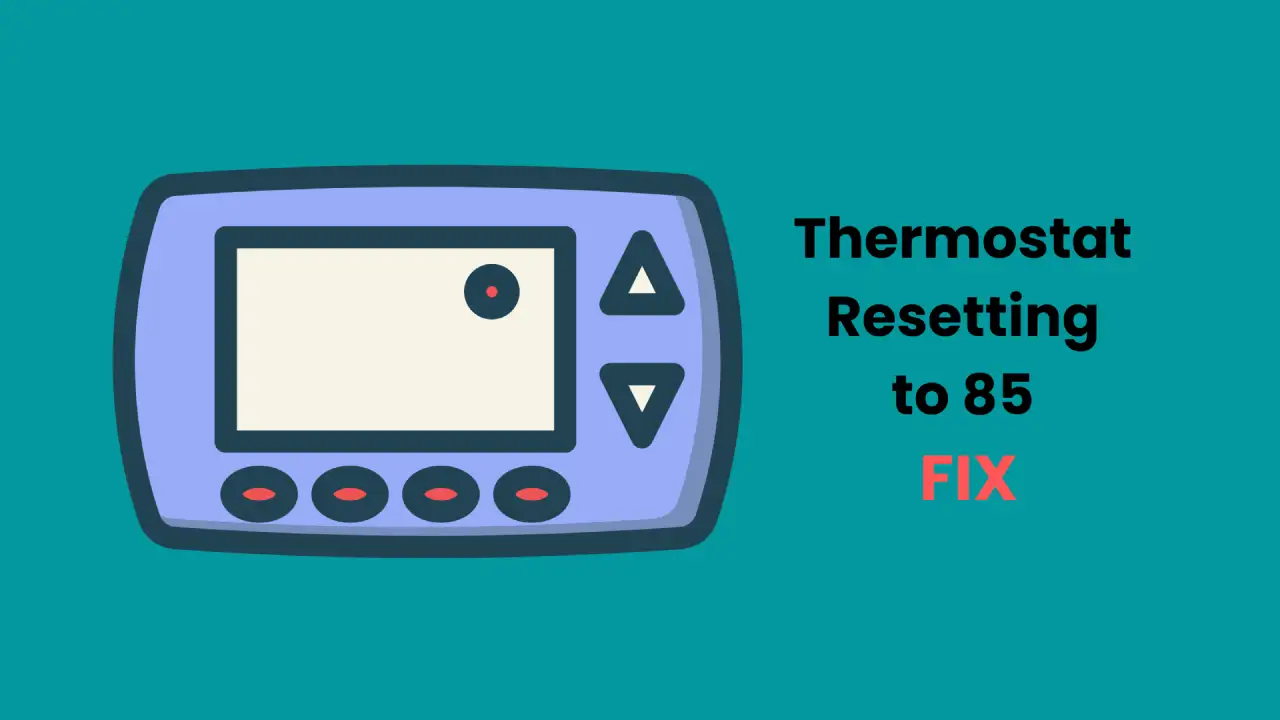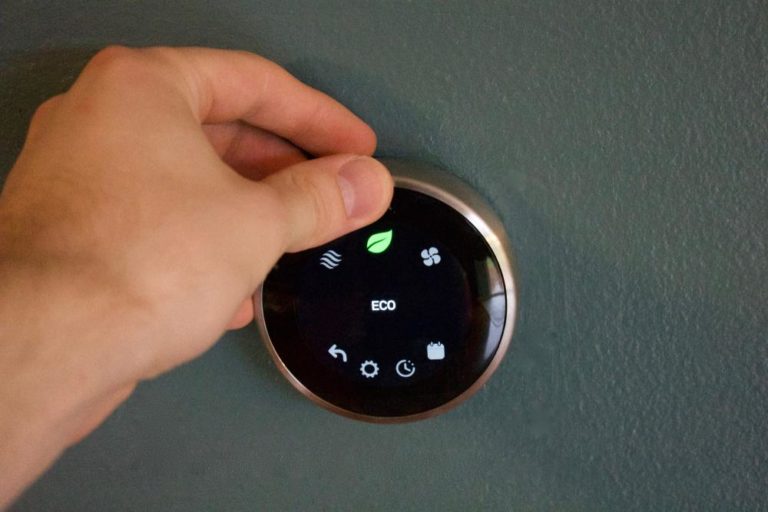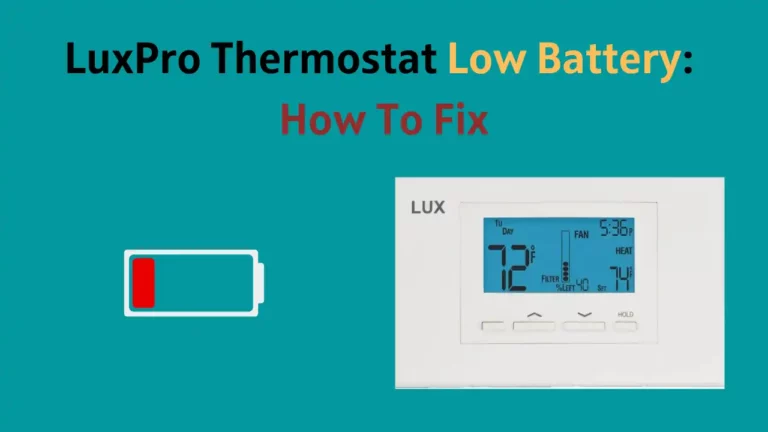Most households owning programmable thermostat model are prone to run across an issue with the thermostat occasionally, and the issue is a continuous resetting of the temperature to 85 F.
Wiring problems, programmed thermostats or burnt fuses are only a couple of the causes for a thermostat that continuously resets itself to 85 degrees F.
Here are some of the reasons why your AC thermostat keep resetting to 85:
- Your Thermostat Is Programmed Default To 85 Degrees
- New Batteries Replacement is Required
- Thermostat Fuse Has Blown
- Thermostat Has Wiring Issues
Fortunately, identifying and fixing the issue is usually simple; replacing your thermostat should only be the last choice.
So, what “typical” causes may this have, and how might it be fixed? In this article, we’ll go over the most probable causes of thermostat resets for your convenience. We’ll also provide fixes to get rid of the problems:
Why Does My Thermostat Keep Resetting To 85? Possible Reasons

Your Thermostat may keep resetting to 85 for a variety of reasons. We’ve compiled a list of the most common causes:
Thermostat Is Programmed To 85 Degrees
If your thermostat has a pre programmed temperature to 85 degrees, it will always return to this setting whenever there are problems with the electricity or programming problems.
If you have a smart thermostat, there’s a significant probability that there are some factory-set programs on your device and the configurations are already determined.
So, immediately reach for your thermostat’s owner’s manual or obtain a copy online and see what the thermostat manufacturer says about thermostat programming. If they have a default setting, no matter what temperature you specify as your desired setting, the application will reset it if there is a default.
The quickest course of action is to consult the handbook because figuring out whether the problem isn’t random would require keeping track of the times when the temperature resets.
New Batteries Replacement is Required
Despite being less common these days, non-programmable thermostats can nevertheless have resetting problems. Issues with the batteries frequently bring these on.
These batteries can occasionally leak solutions, which can lead to thermostat problems. Replace the batteries to solve the issue.
If changing the batteries doesn’t fix the problem, the circuit board may need to be replaced. It’s preferable to get a new thermostat in this situation.
Thermostat Fuse Has Blown

There is a fuse within your thermostat, and if it blows, problems as such will result. The fuse can go blank or shut down altogether.
Examining a blown fuse is similar to examining a lamp for blown electrical components. Look inside your thermostat for a little transparent cylinder by opening it up.
There is a filament running through the fuse. The blown fuse has to be replaced if the small filament inside is damaged.
Thermostat Has Wiring Issues
Your thermostat cannot work properly if there is a short circuit or a loose connection. Because of this, regularly examining your home for loose and damaged wiring is a good idea. Doing this will allow you to rule out this issue in the future.
This could be a good opportunity to inspect your wiring if you haven’t in a while. Your thermostat may have been resetting because of a fault that an experienced hvac technician may discover.
Related Article- Nest Thermostat Not Turning on AC: How To Fix
How To Fix A Thermostat That Keeps Resetting To 85?

Buy New Thermostat Batteries
Your thermostat’s batteries may have run out, which would explain why it keeps returning to the pre-set cooling settings. You must open the unit and extract the inserted batteries to check if your system receives enough power through the batteries.
You can check the batteries by inserting them into other devices to see if they are working. If batteries are not working and are dead, purchase new and compatible batteries and insert them.
Check the device’s performance over the following days after the batteries have been added to the thermostat. The device should work fine without any resetting issues with fresh batteries and renewed power.
Check The Connection Points
Always make sure to examine the state of the connecting points if the problems persist even after you’ve reset the battery. Even if you have installed brand-new batteries, loose connection points prevent electricity from flowing through the system.
To prevent these power problems, you should ensure that all the connecting points are aligned and connected properly.
When the wiring is in pristine condition, the bulk of power-related problems may typically be resolved by fixing the connecting points.
Update the cooling modes
If you update the cooling modes too often of the thermostat, it also resets the cooling configurations to 85.
However, it is no reason to be anxious if this problem persists even after upgrading the cooling mode. Bother with the cooling modes again; tweak the setups one more time.
If you keep fiddling with the cooling modes, remember that your thermostat will keep resetting to 85.
Fix Wiring Issues
Although wire-related problems are rare, you should consider examining the wiring if you’ve just installed the device and started experiencing this problem immediately.
Looking for faulty wiring doesn’t take time, and you can run your eyes to see if wires are frayed or connected to the wrong joints.
Also, examine the connecting points to see if they are placed properly and secure loose ones and if you find any stray ones, make sure to connect them to their due point. If wiring caused the resetting problem, you are sorted at this step.
Reprogram Cooling Schedules
To prevent problems with the device resetting to 85, some thermostat models have weekly schedules that need to be updated.
Therefore, be careful to review daily plans if you haven’t programmed the device precisely and it continues resetting to 85 at the end of each day.
You’ll undoubtedly discover programming errors, and once you adjust the daily schedules for every day of the week, the device will function flawlessly.
Reset Thermostat
This is the step that should be treated as the last resort, as resetting the thermostat clears all your settings, preferences and changes that you have made.
This erases your device’s memory and restores it to its default, factory setting, or manufacture-set preferences.
To reset your thermostat, you need something sharp, such as a safety pin or a paper clip to push the reset button on the device.
The device usually resets in 10 seconds. After that, you can make the settings as per your choice. Your problem will be resolved if there are no further hardware issues with your device.
Why is My Thermostat Keep Resetting?
To determine why your thermostat keeps resetting, you need to identify whether you have a programmable or non-programmable model.
The two types of thermostats may repeatedly reset for various reasons, and there may be different solutions to the problem depending on the cause.
If your thermostat is programmable, you can usually set it to temporary or permanent “Hold.” You might also be experiencing a “demand response event.”
If the thermostat is not programmable, there may be an issue with the internal circuit board or the batteries that can damage the hardware.
How To Know If Your Thermostat is faulty?
Here are a few things to look for to know if your thermostat is faulty:
HVAC System Repeatedly Turning On And Off
Your thermostat’s primary job is interacting with your home’s HVAC system. If the HVAC repeatedly turns on and off, the thermostat is probably the source of the issue.
The issue will likely be because of frayed or broken wiring or a defective battery.
Getting the thermostat examined as soon as possible is important to avoid worsening the problem. You can try troubleshooting on your own before calling a specialist.
Thermostat Showing Incorrect Temperatures Readings
A thermostat that displays inaccurate values is malfunctioning. Replace the batteries in your thermostat and try resetting it if it starts reporting inaccurate temps.
You should contact a specialist if neither of these solutions works. You could need to replace the thermostat totally, or the thermostat may have faulty wiring.
The Thermostat is Changing temperature continuously
You know your thermostat is faulty if it is changing the temperature continuously. Accurate temperature settings will be challenging for a broken thermostat to maintain.
After programming, it might abruptly alter continually or fail to attain the desired temperature. You can try to reset the circuit breaker and re-program the thermostat.
HVAC System Is Short Cycling
A thermostat that is short cycling back-to-back is either broken or outdated. Recycling is used when the HVAC system continually turns on and off before it should.
If your thermostat frequently switches off after 5 minutes of use and then comes back on after 2 minutes, there may be a problem with brief cycling.
Short cycling is frequently caused by a thermostat that has reached the end of its useful life. However, it can also be caused by poor wiring.
Why Does The Thermostat Temperature Keep Dropping?

Frozen Outdoor Unit
In chilly weather, snow and ice are extremely common. If your AC units coil is mounted outside, it may have an ice film on it during a snowfall.
In such conditions, the convection process between the refrigerant and the outside air cannot happen if the coils are entirely covered with ice, and the temperature will keep dropping.
Incorrect Furnace Size
An improperly sized furnace may result in heating problems within a house. A too-big furnace could heat the air too rapidly, causing it to overheat before the thermostat anticipates.
In such a situation, working the AC Thermostat is almost redundant as no matter what temperature you set the device on, the set temperature will be below the threshold.
How Do I Reset The Thermostat On My AC?
Resetting your thermostat will return it to its default settings, which might help you fix programming, HVAC, and thermostat connection problems.
Another reason to reset your thermostat is if you find yourself turning up your heating or cooling but still can’t manage to get your home to the temperature you want and have it remain there.
You may reset a non-programmable thermostat by simply removing the face and pushing the reset button for five seconds. Your thermostat should reset once this action has been taken.
Or you can manually reset your thermostat by switching it off. After turning off the breaker for your HVAC system by locating it and waiting for 30 seconds, re-engage the breaker and restart your thermostat.
Conclusion
Even though a continuously resetting thermostat might be quite frustrating, it is usually rather simple to identify the cause of resetting the temperature to 85 and fix the problem on your own.
The problem may be with the wiring in your home. Check your breaker box and fuses to make sure they are all in good shape. If you have an older home, it’s likely that the original wiring is no longer up to code and needs to be replaced.
If your thermostat is brand new, there could be a defect with the unit itself. Contact the manufacturer for help troubleshooting or replacing your thermostat.
No matter what the cause of your air conditioners thermostat resetting, we hope this article has given you helpful tips on how to fix it. If you still need assistance after trying these solutions, don’t hesitate to contact us for help. We want to make sure that you stay comfortable during these hot summer months!







